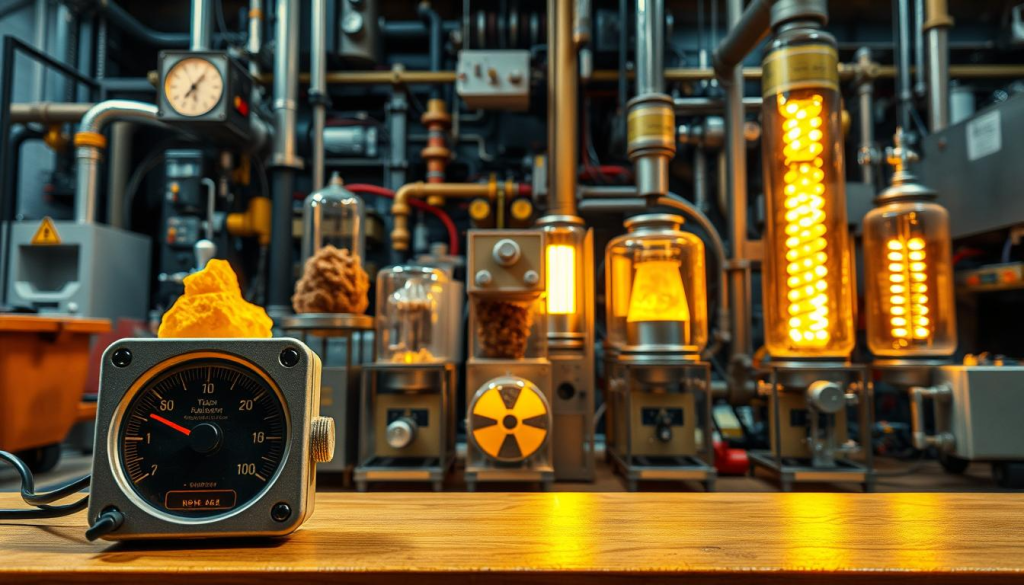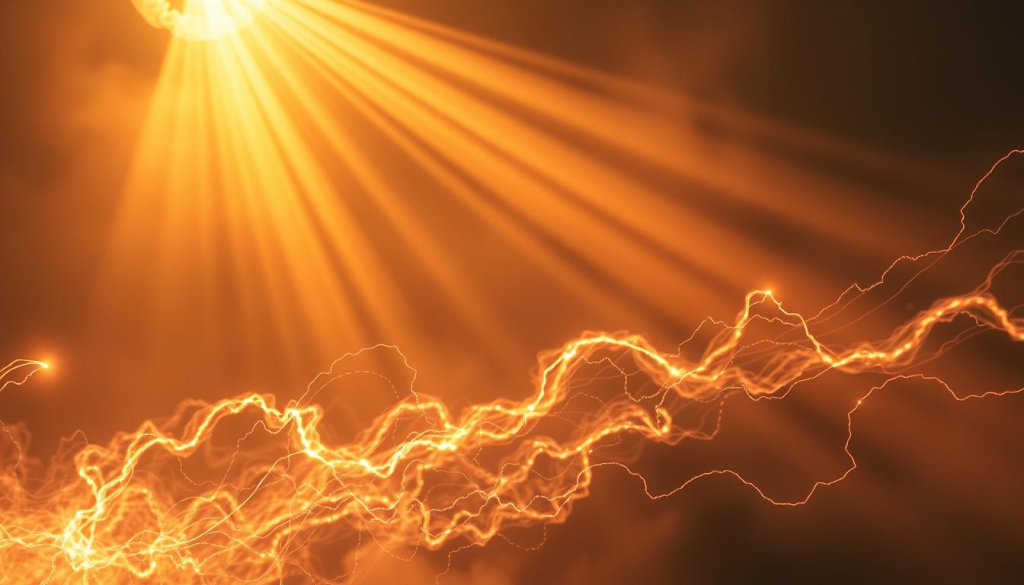
We are surrounded by radiation energy every day. It comes from natural sources like the sun and granite countertops. It also comes from man-made sources like medical imaging and consumer electronics.
Knowing about radiation helps us make better choices for our health and safety. Radiation is a form of energy that moves as waves or particles. It’s found everywhere in nature and technology.
At Liv Hospital, we aim to give top-notch healthcare. We also offer full support and guidance to international patients. In this article, we’ll look at the different kinds of radiation, where they come from, and how they affect our health.

Radiation is everywhere, coming from nature and human-made things. We find it in many forms around us. Knowing about its types and sources helps us understand why safety is key.
Radiation energy is energy that spreads out in waves or particles. The International Atomic Energy Agency says it’s when energy is released as waves or particles. This energy can either ionize or not ionize atoms and molecules.
Ionizing radiation can take away electrons from atoms, making ions. This includes X-rays, gamma rays, and some ultraviolet light. Non-ionizing radiation, with less energy, can make atoms vibrate or rotate. This includes radio waves, microwaves, and visible light.
Radiation comes from nature and human activities. Natural sources are cosmic radiation, radon gas, and radioactive isotopes in the earth. Man-made sources include X-rays, CT scans, nuclear power plants, and some products we use.
To understand radiation sources better, let’s look at a table:
| Source Type | Examples | Description |
| Natural | Cosmic Radiation, Radon Gas | Originates from outer space and the earth’s crust |
| Man-Made | Medical Imaging, Nuclear Power Plants | Generated by human activities and technologies |
It’s important to know the difference between natural and man-made radiation. We can’t control natural radiation, but we can manage man-made sources for safety.

Radiation is everywhere, and knowing its effects can change your life. We’re exposed to different kinds of radiation every day. This includes the sun’s rays and the devices we use. It’s important to understand radiation to protect our health and safety.
We often hear about radiation in news about nuclear accidents or medical treatments. But it’s more common than we think. Knowing about radiation helps us see its good and bad sides. For example, it’s used in medicine to help diagnose and treat diseases, but it can be dangerous if not used right.
The Importance of Radiation Awareness
The science of radiation is about knowing its types and how it affects things. There are two main types: ionizing and non-ionizing radiation. Each type has its own way of interacting with living things.
| Type of Radiation | Characteristics | Examples |
| Ionizing Radiation | High energy, can remove electrons from atoms | Gamma rays, X-rays |
| Non-Ionizing Radiation | Lower energy, cannot remove electrons from atoms | Radio waves, microwaves |
Understanding these concepts helps us see how radiation affects our lives. This knowledge lets us make better choices and appreciate the science behind it.
Radiation has two main types, each with its own effects on health. Knowing the difference is key to understanding the risks and benefits of radiation.
Ionizing radiation can knock electrons out of atoms, creating ions. This includes X-rays, gamma rays, and some ultraviolet rays. It can harm DNA in cells, leading to cancer or genetic changes.
Non-ionizing radiation has less energy but can make atoms vibrate or rotate. It includes radio waves, microwaves, and infrared radiation. While safer, high levels can cause tissue heating and other effects.
Ionizing radiation is more dangerous because it can damage DNA. So, it’s tightly controlled in places like nuclear plants and medical facilities. Protective measures are essential.
Non-ionizing radiation is seen as safer but not risk-free. For example, strong microwave exposure can heat tissues. So, there are safety rules for things like microwave ovens and cell phones.
To wrap up, here’s what you need to know:
Radiation is a double-edged sword. It can harm us but also heal. We will dive into how it damages cells and its role in medicine, like fighting cancer.
Radiation can mess with our cells by changing their DNA. This can lead to mutations and cancer. When radiation hits DNA, it can break DNA strands, causing mutations. These mutations can mess up cell function, leading to cancer.
Radiation is key in medicine, for imaging and cancer treatment. Radiation therapy is a top cancer treatment. It uses high doses to kill cancer cells or slow them down.
In cancer treatment, radiation therapy aims to hit cancer cells hard but spare healthy ones. New tech makes radiation therapy more precise, boosting success rates. Below, we show the different radiation therapy types used in cancer treatment.
| Type of Radiation Therapy | Description | Application |
| External Beam Radiation Therapy (EBRT) | Delivers radiation from outside the body | Commonly used for various cancers |
| Internal Radiation Therapy (Brachytherapy) | Places radioactive material inside the body | Used for localized tumors |
| Stereotactic Body Radiation Therapy (SBRT) | Delivers high doses of radiation precisely | Effective for small, well-defined tumors |
To stay safe from radiation, we need international rules and personal safety steps. These are key for workers, patients, and everyone else.
We follow guidelines and standards to cut down radiation exposure. These rules come from international groups and are based on the latest science.
International rules are the core of keeping us safe from radiation. Groups like the International Commission on Radiological Protection (ICRP) and the Nuclear Regulatory Commission (NRC) in the United States make these rules.
The ICRP’s advice is used worldwide. It covers things like safe doses for workers and the public, handling radiation sources, and emergency situations.
“The fundamental principle of radiation protection is to keep doses as low as reasonably achievable (ALARA), taking into account economic and societal factors.” – ICRP
| Organization | Role in Radiation Protection | Key Guidelines |
| ICRP | Sets global recommendations on radiation protection | ALARA principle, dose limits |
| NRC | Regulates nuclear safety in the United States | Licensing of nuclear facilities, radiation safety standards |
Personal protection gear (PPE) is essential for those around radiation. This includes lead aprons, thyroid shields, and dosimeters.
Lead aprons, for example, protect against X-rays in medical settings. Most are 0.5 mm thick, which blocks diagnostic X-rays well.
Monitoring work exposure to radiation is key. It helps keep workers’ doses safe. This is done with dosimeters and keeping records.
Good monitoring protects workers and improves safety at work.
By following international rules, using PPE, and monitoring work exposure, we can lower radiation risks a lot.
Our homes and personal items are filled with devices that send out radiation. These include things like household appliances and personal electronics. Knowing how much radiation they give off helps us use them safely.
Many home appliances send out some radiation. For example, microwaves use special radiation to heat food. This radiation stays inside the microwave, but it’s key to keep it in good shape to avoid leaks. Other items like refrigerators and air conditioners don’t usually send out much radiation.
Here’s a list of common household appliances and their radiation profiles:
Things like smartphones and laptops send out non-ionizing radiation. The amount of radiation they give off changes based on the device and how it’s used. For instance, smartphones send out more radiation when they’re sending data than when they’re just sitting there.
Some key points to consider:
There’s a lot of wrong information about radiation from consumer electronics. Let’s clear up some common myths:
Medical imaging technologies are getting better, and it’s key to know their good and bad sides. These tools help doctors find and treat many health issues. But, it’s important to remember the risks of radiation.
X-rays are a big deal in medicine. They use X-rays to see inside the body. X-rays are great for checking bones, lungs, and some tumors. But, they do involve radiation, which might raise cancer risk.
CT scans give detailed views of the body in slices. They’re super helpful for spotting complex issues like internal injuries and cancers. Yet, they use more radiation than X-rays, so they need careful use.
Not all imaging needs radiation. MRI and Ultrasound don’t use it. MRI is top-notch for soft tissue like the brain and joints. Ultrasound uses sound waves to see organs and is safe during pregnancy.
Knowing about these imaging options helps everyone make smart choices. It’s about finding the right balance between getting the most info and keeping radiation risks low.
The electromagnetic spectrum is incredibly vast, spanning from long radio waves to short gamma rays. It includes different types of electromagnetic radiation. Each type has its own unique properties and how it interacts with matter.
The spectrum covers a wide range of wavelengths. Radio waves can be as long as kilometers. On the other end, gamma rays are shorter than a nanometer.
Let’s look at the different types of radiation in the spectrum:
| Type of Radiation | Wavelength Range | Frequency Range |
| Radio Waves | 1 mm to 100 km | 3 kHz to 300 GHz |
| Microwaves | 1 mm to 1 m | 300 MHz to 300 GHz |
| Infrared | 700 nm to 1 mm | 300 GHz to 430 THz |
| Visible Light | 400 nm to 700 nm | 430 THz to 750 THz |
| Ultraviolet | 10 nm to 400 nm | 750 THz to 30 PHz |
| X-rays | 0.01 nm to 10 nm | 30 PHz to 30 EHz |
| Gamma Rays | Less than 0.01 nm | More than 30 EHz |
The human eye can only see a small part of the electromagnetic spectrum, known as visible light. This narrow range lets us see the world but limits our understanding of other radiation types.
Different wavelengths of electromagnetic radiation interact with matter in various ways. For example, gamma rays can go deep into materials. On the other hand, radio waves are great for long-distance communication. Knowing how these interact is key for many fields like medicine and technology.
For more info on the electromagnetic spectrum, check out NASA’s educational content on the subject.
Radiation Measurement and Detection Technologies
Radiation measurement technologies are key in managing radiation exposure. They help us detect and measure radiation levels. This is important in places like hospitals, factories, and nature.
Geiger counters and scintillation detectors are common tools for finding radiation. Geiger counters are simple but effective. They use a gas-filled tube to detect ionizing radiation.
Scintillation detectors are more sensitive. They can tell us about the energy of the radiation. This is because they emit light when hit by radiation, with the light’s intensity showing the energy.
We use Sieverts, Grays, and Rems to measure radiation. The Sievert (Sv) and Rem show the biological effect of radiation. The Gray (Gy) tells us how much radiation energy is absorbed by tissue.
| Unit | Description | Application |
| Sievert (Sv) | Measures equivalent dose, accounting for biological effect | Radiation protection, health physics |
| Gray (Gy) | Measures absorbed dose, energy deposited per unit mass | Radiation therapy, radiation safety |
| Rem | Older unit for equivalent dose, similar to Sievert | Legacy applications, some radiation safety |
Radiation mapping creates detailed maps of radiation levels. It’s vital for keeping the environment safe and planning for emergencies. Advanced tech, like airborne and satellite detectors, helps map radiation over big areas.
By using these technologies, we can handle radiation risks better. This is true in fields like medicine and energy production.
Earth’s atmosphere protects us from cosmic radiation. It does this in many ways, using the magnetosphere and different layers of our atmosphere.
The magnetosphere is a shield around Earth. It’s made by Earth’s magnetic field and interacts with the solar wind. This field deflects charged particles from the solar wind and deep space.
It’s our first defense against cosmic radiation. It protects us from the strongest solar flares and coronal mass ejections.
Our atmosphere has many layers, each protecting us in its own way. The troposphere, stratosphere, mesosphere, thermosphere, and exosphere all help absorb or deflect radiation.
The stratosphere has the ozone layer, which is key for absorbing UV radiation from the Sun. This helps keep the atmosphere healthy and effective in shielding us from radiation.
| Atmospheric Layer | Primary Function | Role in Radiation Protection |
| Troposphere | Weather and climate regulation | Absorbs some radiation, contributes to overall atmospheric shielding |
| Stratosphere | Contains the ozone layer, absorbs UV radiation | Protects life on Earth, maintains atmospheric health |
| Mesosphere | Protects Earth from meteoroids | Absorbs some cosmic radiation, meteors burn up here |
Astronauts face risks from cosmic radiation when they go beyond low Earth orbit. This is a big concern for missions to the Moon and Mars. It can harm both the human body and electronic equipment.
Astronauts on the International Space Station get some protection. But those on deep space missions face more radiation. It’s important to understand and reduce these risks for future space missions.
Radiation, when controlled, brings many benefits to industries and science. It’s used in many ways, like keeping food fresh and creating nuclear energy. This shows how useful and vital it is.
Food irradiation uses controlled radiation to kill bacteria and keep food fresh longer. It’s great for fruits, veggies, and meats. This method helps prevent foodborne illnesses and reduces spoilage during transport and storage.
In industries, controlled radiation helps with quality checks and material tests. Radiography lets us see inside materials and welds without harming them. This is key in fields like aerospace, auto, and construction, where material safety is essential.
Nuclear energy comes from nuclear fission, where atoms split to release energy. This energy makes steam, which powers turbines to create electricity. Nuclear plants are a big source of electricity worldwide, a cleaner option than fossil fuels.
In science, controlled radiation is used in many studies. It helps in medical research to understand radiation’s effects on living things and find new disease treatments. It’s also used to sterilize medical tools and study material properties.
By using controlled radiation, we make progress in health, industry, energy, and science. It’s a powerful tool for discovery and improvement.
Understanding radiation is key to making smart choices about our health and safety. It’s everywhere, and knowing the basics helps us deal with it. Radiation is not just bad; it’s also useful in medicine and industry.
Radiation has two sides: it can hurt us or help us. Knowing this is important for using its good sides while avoiding the bad. We see radiation all around us, from nature to technology, and understanding it is critical.
Being aware of radiation lets us control our exposure and use its benefits. We hope this article has given you a clear view of radiation. Now, you can handle its complexities with confidence and knowledge.
Radiation is energy from natural and man-made sources. It can harm our health by damaging cells, leading to cancer. But, it’s also used in medicine to help diagnose and treat diseases.
There are two main types: ionizing and non-ionizing. Ionizing radiation, like X-rays, can damage DNA and harm living things. Non-ionizing radiation, such as radio waves, has less energy but can cause heating.
We can protect ourselves by following safety rules and using protective gear. We should also limit our use of devices that emit radiation. And, we need to follow safety steps during medical imaging.
Radiation helps in diagnosing and treating diseases, including cancer. It targets cancer cells while protecting healthy tissues. Medical imaging, like X-rays, uses radiation to create detailed body images.
The Earth’s atmosphere shields us from cosmic radiation. The magnetosphere and atmospheric layers work together to protect us. But, astronauts in space face higher levels of cosmic radiation, posing a challenge for space travel.
Controlled radiation has many uses, like food preservation and quality control. It’s also used in nuclear energy and scientific research. These uses improve our lives and help us understand the world.
We measure and detect radiation with tools like Geiger counters. These devices help us understand radiation levels. Units like sieverts and grays quantify radiation exposure.
Most consumer electronics, like appliances and personal devices, emit low levels of radiation. These levels are considered safe. But, it’s important to follow safety guidelines to minimize exposure.
Subscribe to our e-newsletter to stay informed about the latest innovations in the world of health and exclusive offers!
WhatsApp us